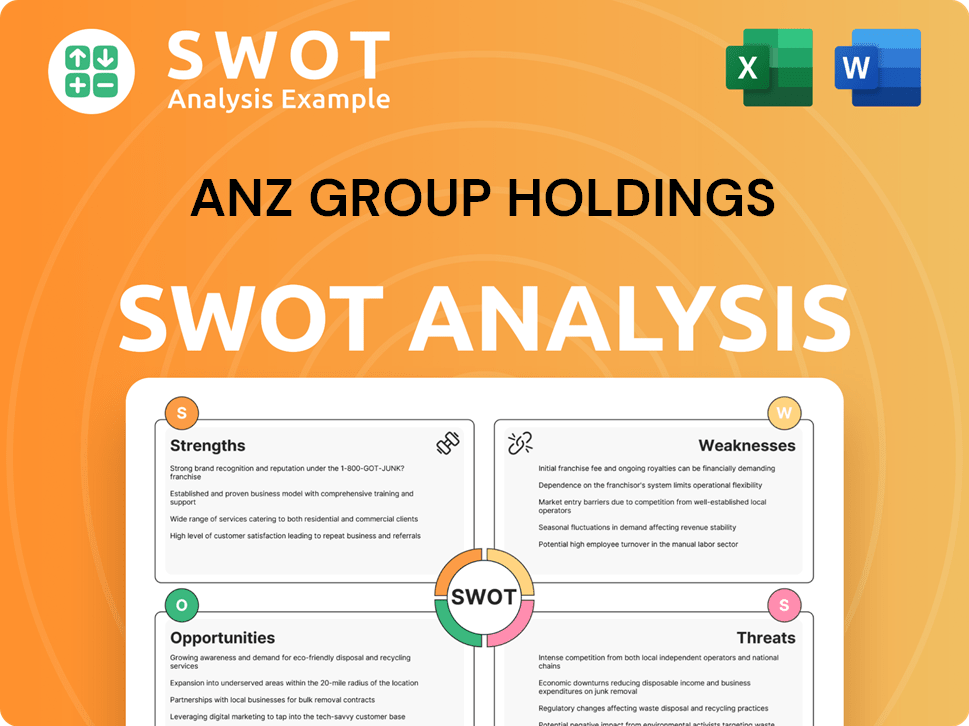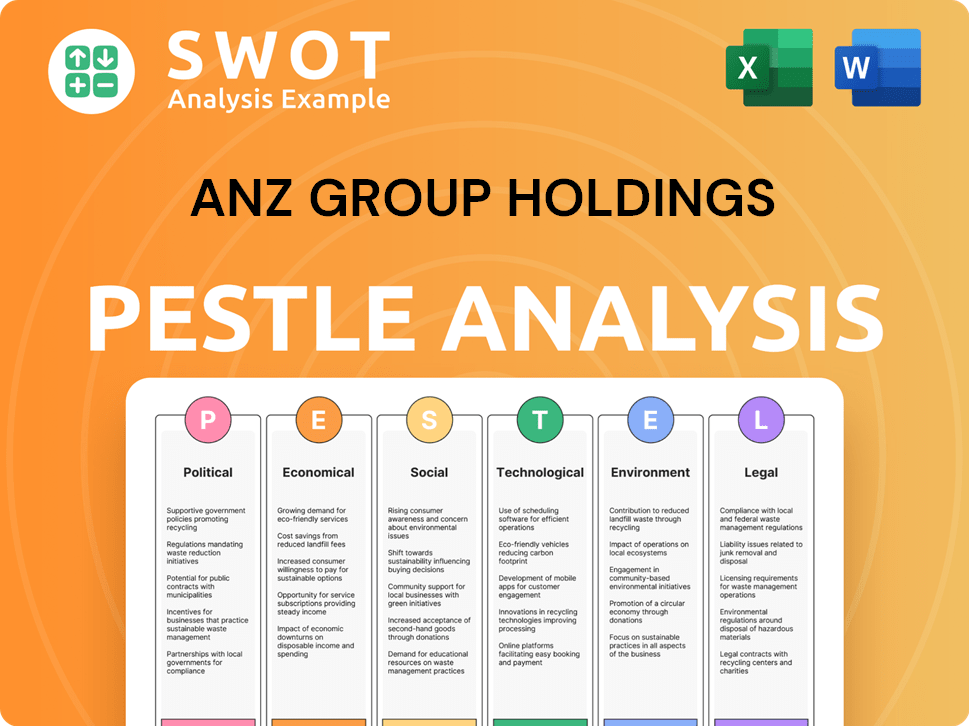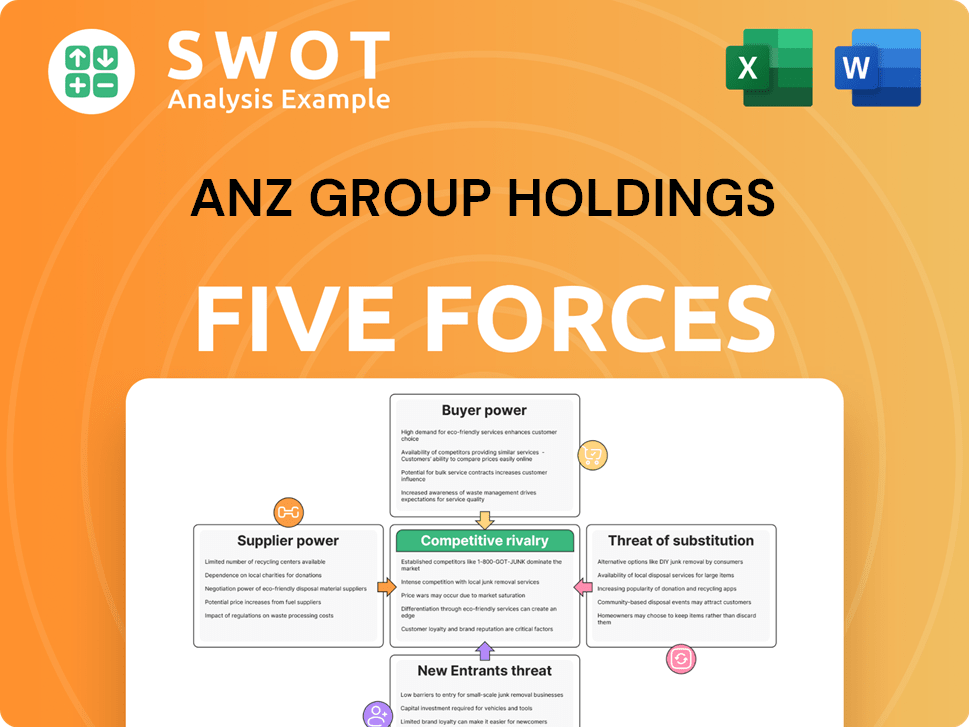ANZ Group Holdings Bundle
Who Really Owns ANZ Group Holdings?
Unraveling the ANZ Group Holdings SWOT Analysis is just the beginning. Understanding the ownership structure of ANZ, a leading financial institution, is critical for investors and stakeholders alike. But who are the key players behind this banking giant, and how has its ownership evolved over time?

The shift to ANZ Group Holdings Limited in early 2023, replacing Australia and New Zealand Banking Group Limited (ANZBGL), marked a pivotal moment in the company's history. This restructuring, which involved shareholders exchanging their existing ANZ shares, underscores the importance of understanding the current ANZ ownership landscape. From its origins in 1828 to its current status as a major player in the Asia-Pacific region, this analysis will delve into the details of ANZ shareholders and the forces shaping its future. We will explore the role of institutional and individual investors and answer the question: Who controls ANZ Bank?
Who Founded ANZ Group Holdings?
The ownership structure of ANZ Group Holdings Limited is complex, evolving through a series of mergers rather than a single founding event. Tracing the initial ownership of ANZ Group Holdings involves understanding the historical mergers that formed the company. The earliest predecessor of ANZ, the Bank of Australasia, began operating in 1828.
The formation of ANZ Group Holdings is rooted in the merger of several historical banking entities. The Australia and New Zealand Banking Group Limited, the direct predecessor to the current ANZ Group Holdings Limited, was officially formed in 1970. Given its history through mergers, detailed records of individual founders' equity splits are not readily available.
Early ownership of ANZ Group Holdings was shaped by the amalgamation of shareholding bases from the merging entities. Early backers were the original shareholders of these independent banks. There is no public information detailing initial ownership disputes or specific agreements that directly shaped the current ANZ Group Holdings structure.
The Bank of Australasia, a key ancestor of ANZ, started in 1828. This early start is crucial to understanding the evolution of ANZ's ownership.
The merger of the Bank of Australasia and the Union Bank of Australia in 1951 was a significant step. This merger formed ANZ Bank, reshaping the shareholder base.
The 1970 merger with the English, Scottish & Australian Bank was pivotal. This merger led to the creation of the Australia and New Zealand Banking Group Limited.
ANZ ownership evolved through the integration of shareholding from merging entities. This makes it difficult to pinpoint a single founding ownership structure.
Detailed records of individual founders' equity splits are not readily available. The focus is on the collective shareholder base from the merging banks.
Early investors were the original shareholders of the independent banks. Their influence and initial capital contributions shaped the early direction of the banks.
Understanding the history of ANZ Group Holdings is essential for grasping its ownership structure. The company's evolution through mergers has created a complex ownership landscape. For more insights into the company's strategic direction, consider exploring Target Market of ANZ Group Holdings.
- The direct founding ownership structure is rooted in mergers.
- Early backers were the original shareholders of the independent banks.
- Detailed records of individual founders' equity splits are not readily available.
- ANZ Group Holdings' history is marked by significant mergers.
ANZ Group Holdings SWOT Analysis
- Complete SWOT Breakdown
- Fully Customizable
- Editable in Excel & Word
- Professional Formatting
- Investor-Ready Format

How Has ANZ Group Holdings’s Ownership Changed Over Time?
The ownership structure of ANZ Group Holdings Limited has seen significant changes, especially with the shift to a non-operating holding company (NOHC) structure on January 3, 2023. This change established ANZ Group Holdings Limited (ANZGHL) as the new listed parent company. Shareholders exchanged their existing Australia and New Zealand Banking Group Limited (ANZBGL) shares for ANZGHL shares. This restructuring aimed to separate ANZ's banking and non-banking businesses, potentially fostering innovation and growth in non-banking sectors.
The transition to the NOHC structure marked a pivotal moment in the evolution of ANZ's ownership. This move aimed to streamline operations and potentially enhance strategic flexibility. The implications of these changes continue to unfold, influencing how the company navigates the financial landscape.
| Major Shareholders | Shares Held | Percentage of Ownership |
|---|---|---|
| The Vanguard Group, Inc. (May 7, 2025) | 106.64 million | 3.59% |
| State Street Global Advisors, Australia, Ltd. (December 16, 2024) | 151.96 million | 5.11% |
| BlackRock Fund Advisors (October 1, 2024) | 87.75 million | 2.95% |
| Norges Bank Investment Management (December 31, 2024) | Data available | 1.8% |
Institutional investors hold a significant stake in ANZ Group Holdings. According to TipRanks data, institutional investors own approximately 12.65% of the stock, while public companies and individual investors hold about 87.33%. Insiders hold a very small percentage, around 0.02%. The presence of large institutional investors generally implies a focus on long-term value creation and can influence corporate governance. For more details on the company's financial performance, you can explore the Revenue Streams & Business Model of ANZ Group Holdings.
ANZ Group Holdings' ownership structure has evolved, with a shift to a NOHC structure in 2023. Several institutional investors hold significant stakes in ANZ, influencing corporate governance.
- The Vanguard Group, Inc. is a major shareholder.
- State Street Global Advisors, Australia, Ltd. also holds a substantial stake.
- Institutional investors collectively own a significant portion of the company.
- The NOHC structure aims to separate banking and non-banking businesses.
ANZ Group Holdings PESTLE Analysis
- Covers All 6 PESTLE Categories
- No Research Needed – Save Hours of Work
- Built by Experts, Trusted by Consultants
- Instant Download, Ready to Use
- 100% Editable, Fully Customizable

Who Sits on ANZ Group Holdings’s Board?
As of May 2025, the Board of Directors of ANZ Group Holdings Limited (ANZ Group Holdings) plays a critical role in the company's governance. The board includes seven independent Non-Executive Directors and one Executive Director, the Chief Executive Officer. This structure ensures independent oversight and strategic direction for the financial group. The board members, as of May 2025, include Paul O'Sullivan as Chairman, Nuno Matos as CEO, and other Non-Executive Directors such as Christine O'Reilly, Alison Gerry, Holly Kramer, Scott St John, Jeffrey Smith, and Richard Gibb.
The composition of the board reflects a commitment to independent oversight, with the Non-Executive Directors not directly representing specific major shareholders. Recent changes include the appointment of Alison Gerry in May 2025 and the departures of Jane Halton in March 2025. These changes highlight the dynamic nature of corporate governance and the importance of maintaining a diverse and experienced board to guide the company's strategic direction. The Growth Strategy of ANZ Group Holdings is heavily influenced by the board's decisions.
| Board Member | Role | Date Joined |
|---|---|---|
| Paul O'Sullivan | Chairman, Independent Non-Executive Director | N/A |
| Nuno Matos | Chief Executive Officer, Executive Director | May 12, 2025 |
| Christine Elizabeth O'Reilly | Non-Executive Director | N/A |
| Alison Rosemary Gerry | Non-Executive Director | May 9, 2025 |
| Holly Suzanna Kramer | Non-Executive Director | N/A |
| Scott Andrew St John | Non-Executive Director | March 25, 2024 |
| Jeffrey Paul Smith | Non-Executive Director | N/A |
| Richard Boyce Massey Gibb | Non-Executive Director | February 15, 2024 |
The voting structure for ANZ Group Holdings generally follows a one-share-one-vote principle, common in publicly traded companies. This structure ensures that all shareholders have voting rights proportional to their share ownership. There are no special voting rights or founder shares that would grant disproportionate control to certain individuals or entities. This structure supports fair governance and transparency, which is crucial for investor confidence.
- One-share-one-vote structure.
- Focus on shareholder engagement.
- Commitment to timely and balanced disclosure.
- Comprehensive risk management framework.
ANZ Group Holdings Business Model Canvas
- Complete 9-Block Business Model Canvas
- Effortlessly Communicate Your Business Strategy
- Investor-Ready BMC Format
- 100% Editable and Customizable
- Clear and Structured Layout

What Recent Changes Have Shaped ANZ Group Holdings’s Ownership Landscape?
Over the past few years, several significant developments have shaped the ownership landscape and strategic direction of ANZ Group Holdings. A notable aspect is the ongoing share buy-back program, initiated on May 7, 2024, designed to optimize the company's capital structure and potentially boost shareholder value. This program reflects a proactive approach to capital management, with ANZ announcing its intention to repurchase up to $2 billion of shares, subject to market conditions, as of May 7, 2024. For instance, on January 22, 2025, the company bought back 369,318 ordinary shares, and on August 18, 2024, 492,048 shares were repurchased.
Another key development is the acquisition of Suncorp Bank, completed on July 31, 2024. This strategic move is expected to strengthen ANZ's competitive position, particularly in Queensland. In addition to this, ANZ's investment in View Media Group (VMG) in 2023 further indicates its strategic focus. These actions, combined with leadership changes and industry trends, are reshaping the profile of ANZ ownership.
| Key Development | Details | Impact on Ownership |
|---|---|---|
| Share Buy-Back Program | Commenced May 7, 2024; up to $2 billion repurchase. | Reduces outstanding shares, potentially increasing shareholder value. |
| Acquisition of Suncorp Bank | Completed July 31, 2024. | Strengthens market position, particularly in Queensland. |
| Leadership Transition | Nuno Matos appointed CEO, effective May 12, 2025. | Reflects adaptation to market dynamics and strategic priorities. |
Industry trends also influence ANZ's ownership profile. Increased institutional ownership and consolidation within the financial services sector are notable. Major institutional investors, such as BlackRock Inc., The Vanguard Group, and Norges Bank Investment Management, hold significant stakes in ANZ. These trends highlight the evolving dynamics of ANZ shareholders and its position within the broader financial landscape. To learn more about the company's origins, you can read the Brief History of ANZ Group Holdings.
ANZ is a publicly traded company, with ownership primarily distributed among institutional investors and the general public. The major shareholders include institutional investors such as BlackRock Inc., The Vanguard Group, and Norges Bank Investment Management.
The share buy-back program, announced in May 2024, is a key financial activity. The company repurchased 369,318 shares on January 22, 2025, and 492,048 shares on August 18, 2024, as part of this program.
The acquisition of Suncorp Bank, completed on July 31, 2024, is a significant strategic move. This acquisition is expected to strengthen ANZ's position in the Australian financial market, especially in Queensland.
Nuno Matos will become the new CEO, effective May 12, 2025, succeeding Shayne Elliott. This change reflects the company's ongoing efforts to adapt to market dynamics and strategic priorities.
ANZ Group Holdings Porter's Five Forces Analysis
- Covers All 5 Competitive Forces in Detail
- Structured for Consultants, Students, and Founders
- 100% Editable in Microsoft Word & Excel
- Instant Digital Download – Use Immediately
- Compatible with Mac & PC – Fully Unlocked

Related Blogs
- What are Mission Vision & Core Values of ANZ Group Holdings Company?
- What is Competitive Landscape of ANZ Group Holdings Company?
- What is Growth Strategy and Future Prospects of ANZ Group Holdings Company?
- How Does ANZ Group Holdings Company Work?
- What is Sales and Marketing Strategy of ANZ Group Holdings Company?
- What is Brief History of ANZ Group Holdings Company?
- What is Customer Demographics and Target Market of ANZ Group Holdings Company?
Disclaimer
All information, articles, and product details provided on this website are for general informational and educational purposes only. We do not claim any ownership over, nor do we intend to infringe upon, any trademarks, copyrights, logos, brand names, or other intellectual property mentioned or depicted on this site. Such intellectual property remains the property of its respective owners, and any references here are made solely for identification or informational purposes, without implying any affiliation, endorsement, or partnership.
We make no representations or warranties, express or implied, regarding the accuracy, completeness, or suitability of any content or products presented. Nothing on this website should be construed as legal, tax, investment, financial, medical, or other professional advice. In addition, no part of this site—including articles or product references—constitutes a solicitation, recommendation, endorsement, advertisement, or offer to buy or sell any securities, franchises, or other financial instruments, particularly in jurisdictions where such activity would be unlawful.
All content is of a general nature and may not address the specific circumstances of any individual or entity. It is not a substitute for professional advice or services. Any actions you take based on the information provided here are strictly at your own risk. You accept full responsibility for any decisions or outcomes arising from your use of this website and agree to release us from any liability in connection with your use of, or reliance upon, the content or products found herein.